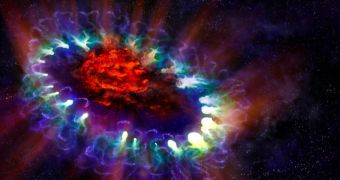A recent study conducted with the Atacama Large Millimeter/sub-millimeter Array (ALMA) has demonstrated that supernova remnants are one of the most important sources of dust in the galaxy.
Astronomers have been arguing for a very long time that supernova remnants (SNR) are a major source of dust for the intra-galactic environment, but evidences to support these claims have been lacking.
Thanks to the amazing capabilities of the international radio telescope that is ALMA, the dust-making capabilities of the famous SNR 1987A have been documented in exquisite detail for the first time ever.
The data the team presented recently indicate that the SNR is literally brimming with freshly formed dust. This discovery may go a long way towards explaining why galaxies are chocked full of dust.
ALMA, the result of collaboration between institutions and universities in Europe, the United States, Canada, East Asia and the Republic of Chile, is a large interferometer made up of radio telescopes.
The facility is located near the Llano de Chajnantor Observatory and Atacama Pathfinder Experiment, and entered service in March 2013. It took $1 billion+ dollars (€733 million+) to complete this project.
ALMA consists of a total of sixty-six, 12-meter and 7-meter (39.3- and 23-foot) antennas, which work together via a process called interferometry. This allows light from all antennas to be merged together.
“We have found a remarkably large dust mass concentrated in the central part of the ejecta from a relatively young and nearby supernova,” says astronomer and study leader Remy Indebetouw.
The expert holds joint appointments with the US National Radio Astronomy Observatory (NRAO) and the University of Virginia, both in Charlottesville. “This is the first time we've been able to really image where the dust has formed, which is important in understanding the evolution of galaxies” he says.
Details of the investigation were presented yesterday at the 223rd meeting or the American Astronomical Society (AAS), being held in Washington DC. A paper was also submitted to the Astrophysical Journal Letters, to appear in a future print issue.
The team told attendants at the AAS meeting that the SNR 1987A, located roughly 168,000 light-years from Earth, is currently producing dust at a furious pace. The material forms from molecules of oxygen, carbon, and silicon that combine once they exit the high-temperature areas of the remnant.
“1987A is a special place since it hasn’t mixed with the surrounding environment, so what we see there was made there. The new ALMA results, which are the first of their kind, reveal a supernova remnant chock full of material that simply did not exist a few decades ago,” Indebetouw concludes.

 14 DAY TRIAL //
14 DAY TRIAL //